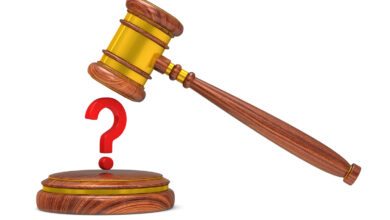Trump’s Assault on the Guardrails of Democracy

“I have the right to do whatever I want as president.” (President Donald J. Trump, July 23, 2019)
Not really, Mr. President.
But not for lack of trying.
The optimistic view following Donald Trump’s election was that even though he might be unfit for office, the constitutional guardrails established by our Founding Fathers would limit the damage he could do.
The Constitution, after all, doesn’t just grant powers to the president, it also limits those powers. Presidential authority is set out in Article II of the Constitution, neatly sandwiched between grants of legislative power to Congress under Article I, and judicial power to the courts under Article III.
The legislative powers that the Constitution granted exclusively to Congress limit presidential authority. Since all revenue bills “shall originate in the House,” Congress has the power of the purse. The Constitution also grants to Congress the power to raise and support an Army and Navy, declare war, confirm or reject key executive appointments, override presidential vetoes, and hold a president accountable through impeachment and removal.
The Constitution further limits presidential power by granting significant responsibilities to the judicial branch. The courts are responsible for ensuring that the other branches of the government, including the president, are acting within their constitutional authority. The framers sought to immunize federal judges from political influence by providing that they “shall hold their Offices during good Behavior,” meaning that they can’t be fired on a whim, only impeached for good cause.
The Founding Fathers did all of this because they didn’t want our new nation to be governed by a king, a dictator or a tyrant. By limiting presidential authority and granting exclusive powers to the other two branches of government, they created robust guardrails to keep executive power in check.
Two and a half years into Donald Trump’s presidency, those guardrails have, for the most part, remained intact.
Not that Trump hasn’t tested them. He has.
For instance, he has used threats and bullying to turn the Senate into more of a lapdog than a watchdog. As long as Republicans remain in control of the Senate, Trump can pretty much rely on them to support anything he proposes and block anything he opposes. Witness Mitch McConnell’s refusal to allow a vote on, or even to propose an alternative to legislation passed by the House to counter cyber-attacks by Russians and other foreign agents.
McConnell’s justification for this position – that the Trump administration has already done enough to combat foreign interference, and that control of elections should be left to the States – is laughable. Trump has not even conceded that Russia interfered with the 2016 election, much less established meaningful safeguards against another such attack in 2020. And national security is not now, and has never been, a matter of states-rights.
What is really happening is that McConnell is killing legislation to safeguard elections because he fears it will anger Trump, who views any talk about foreign election interference as a challenge to the legitimacy of his election.
Trump has also weakened judicial guardrails by salting the federal judiciary with politically sympathetic judges, an alarming number of whom received “Not Qualified” ratings by the non-partisan American Bar Association.
Meanwhile, the Trump-made Supreme Court has issued a series of straight party-line 5-4 decisions that have weakened the guardrails against abuse of presidential power. The Court affirmed Trump’s authority to restrict travel from mostly Muslim countries; upheld transparent, politically motivated voter suppression laws; ruled that immigrants held in detention facilities have no right to a hearing to decide whether they were being legally held; and, most recently, declared open season for state politicians to rig elections by political gerrymandering that the Court itself described as “highly partisan,” “unjust” and “incompatible with democratic principles.”
While the gerrymandering decision applies on its face to both Republicans and Democrats, make no mistake: America’s electoral system gives Republicans a huge structural advantage when it comes to rigging congressional districts.
Yet, despite all of this, it would be a stretch to say that Trump has (yet) fundamentally altered the constitutional balance of powers between the three branches of the federal government.
The same cannot be said, however, of the guardrails Trump has obliterated within the executive branch.
The internal guardrails built into the executive branch are mostly unwritten. They are less formally structured than the external guardrails created by constitutionally dividing government into three co-equal branches. They consist primarily of quasi-legal policies, norms and best practices that reflect the painfully learned lessons of nearly 250 years of the American experiment.
The most fundamental internal protection against presidential abuse of power – the independence, integrity and collective wisdom of the men and women who occupy key cabinet and advisory positions around the president – is also the most fragile. It is theoretically assured only if the president appoints competent, independent-thinking officials and, in the case of those nominees subject to Senate confirmation, only if the Senate is willing to deny confirmation to those who fail to meet that standard.
This is where Trump has blown through the rails.
He has appointed manifestly unqualified political hacks to key posts, put foxes in charge of henhouses, kept his appointees insecure and subservient by naming them only to “acting” positions, avoided the Senate confirmation process whenever possible, and bullied Mitch McConnell’s Senate into granting confirmation when it couldn’t otherwise be avoided.
Examples can be found everywhere within the Trump administration.
Trump grew to detest Chief of Staff John Kelly’s attempt to restrain his worst instincts, so he replaced him with Mick Mulvaney, whose primary qualification appears to have been his promise not to try to rein in the president. Trump designated Mulvaney as an “acting” Chief of Staff. That designation was entirely gratuitous because the Chief of Staff is not subject to Senate confirmation in the first place. The designation seems to have been nothing more than a shot across Mulvaney’s bow to make sure that he didn’t overstep his bounds, and clearly understood that his job would be secure only as long as the mercurial Trump remains pleased with him.
Trump replaced Secretary of Defense James Mattis, the fiercely independent soldier/scholar who was widely regarded as the most reliable adult in the room, with another “acting” official, Patrick Shanahan, a thoroughly unqualified ex-Boeing executive. Shortly after Trump announced that he intended to nominate Shanahan as Mattis’ permanent replacement, Shanahan pulled out of the confirmation process amid reports of spousal abuse.
Think Alabama Senator Jeff Sessions was a ridiculous choice to lead the department responsible for protecting civil and voting rights? Well, Sessions was Bobby Kennedy compared to the guy Trump chose to replace him as Attorney General, Matthew Whitaker.
Whitaker’s resume, in addition to an entirely unremarkable five-year stint as the U.S. Attorney for the Southern District of Iowa (which ended almost a decade before his appointment), included walking away from a taxpayer-subsidized apartment rehabilitation project that was beset with cost overruns; having his affordable housing loan yanked by the City of Des Moines after he defaulted on it; and service on the Board of a company called World Patent Marketing which supported projects to prove the existence of Bigfoot, promise that time travel would be possible within the next decade, and secure a patent for an oversized “masculine toilet.”
Yet Whitaker’s oft-televised insistence “there is no criminal obstruction of justice charge to be had here [against the president]” was all the qualification Trump needed to appoint him to the highest law-enforcement position in government.
Whitaker, too, was tagged with an “acting” label to avoid the embarrassment of a confirmation hearing.
Most recently, Trump has nominated Texas congressman John Ratcliffe to replace Dan Coats as the director of national intelligence. Ratcliffe is so manifestly unqualified that even a handful of Republicans have raised feeble questions about his prospects for confirmation. As the New York Times put it, “for what is supposed to be perhaps the most nonpartisan job in Washington, Mr. Trump selected one of the capital’s fiercest political warriors.”
Ratcliffe, who was a United States Attorney and the mayor of a town of 9000 inhabitants prior to being elected to Congress in 2014, has no significant intelligence experience beyond serving without distinction for less than a year as one of 22 members of the House Intelligence Committee. His main “qualification” appears to be his public skepticism about the CIA’s finding that Moscow interfered in the 2016 election to favor Trump, and his fierce attacks on Robert Mueller and the Russia investigation.
And amazingly enough, even these people are scholars compared to the real hacks in the Trump administration: Donald Trump Jr., Jared Kushner, Ivanka Trump, Wilbur Ross, Sonny Perdue, Ben Carson, Rick Perry, Betsy DeVos, Ryan Zinke, Scott Pruitt, Omarosa Manigault Newman, Tom Price, Keith Schiller, Sebastian Gorka, Steve Bannon, Anthony Scaramucci . . .
I suppose we can take some comfort that Trump has not yet gotten around to firing two national security officials who are well qualified for their jobs, CIA Director Gina Haspel and FBI Director Christopher Wray. Agree or disagree with their politics, both have brought experience, intelligence and a high degree of independence to their crucial jobs.
But if either of them displeases Trump by inconveniently doing their jobs, do you think he would hesitate – even for a second – to replace them, too?
And what’s going to happen if Trump is re-elected to a second four-year term during which he doesn’t have to worry about winning another election?
Having completed his destruction of the internal guardrails inside the executive branch, would he stop there? Or would he begin to attack the guardrails around the other two branches of government? Maybe by refusing to honor and enforce congressional legislation? Or by openly disobeying court orders under a claim of constitutional supremacy?
Americans have spent generations during which the largest threats to our political system were external. Nobody seriously believed we would attack ourselves from within.
But what used to be unthinkable has now crept its way into mainstream thinking, like a horror movie turning into a documentary.
He’s inside the house.





Here’s a brilliantly structured, carefully reasoned rebuttal to my Guardrails column. How could anybody not be convinced by this razor-sharp analysis?